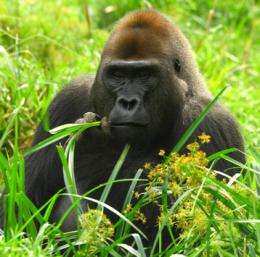Effect of season on the health of apes: A case study of wild chimpanzees and Western gorillas

(Phys.org)—Our closest relatives, the great apes, are all endangered and particularly sensitive to infectious diseases. Both chimpanzees and western gorillas experience seasonal variations in fruit availability but little is know about the effect on their health.
A research team involving the National Museum of Natural History, the National Veterinary School of Alfort, CNRS, WWF and the Project for the conservation of great apes conducted a study that compares the factors influencing the health of two populations of wild chimpanzees and gorillas. This study has been published in the journal Plos One.
Among factors affecting animal health, environmental influences may directly or indirectly impact host nutritional condition, fecundity, and their degree of parasitism.
Our closest relatives, the great apes, are all endangered and particularly sensitive to infectious diseases.
Both chimpanzees and western gorillas experience large seasonal variations in fruit availability but only western gorillas accordingly show large changes in their degree of frugivory.
The aim of this study is to investigate and compare factors affecting health (through records of clinical signs, urine, and faecal samples) of habituated wild ape populations: a community (N=46 individuals) of chimpanzees (Pan troglodytes) in Kanyawara, Kibale National Park (Uganda), and a western gorilla (G. gorilla) group (N=13) in Bai Hokou in the Dzanga-Ndoki National Park (Central African Republic).
Ape health monitoring was carried out in the wet and dry seasons (chimpanzees: July–December 2006; gorillas: April–July 2008 and December 2008–February 2009). Compared to chimpanzees, western gorillas were shown to have marginally greater parasite diversity, higher prevalence and intensity of both parasite and urine infections, and lower occurrence of diarrhea and wounds. In this study, parasite infections (prevalence and load), but not abnormal urine parameters, were significantly higher during the dry season of the study period for western gorillas, who thus appeared more affected by the large temporal changes in the environment in comparison to chimpanzees. Infant gorillas were the most susceptible among all the age/sex classes (of both apes) having much more intense infections and urine blood concentrations, again during the dry season. Long term studies are needed to confirm the influence of seasonal factors on health and parasitism of these great apes.
However, this study suggest climate change and forest fragmentation leading to potentially larger seasonal fluctuations of the environment may affect patterns of ape parasitism and further exacerbate health impacts on great ape populations that live in highly seasonal habitats.
More information: Masi S., Chauffour S., Bain O., Todd A., Guillot J., and Krief S. (2012) Seasonal Effects on Great Ape Health: A Case Study of Wild Chimpanzees and Western Gorillas. PLoS ONE 7(12): e49805. doi:10.1371/journal.pone.0049805
Journal information: PLoS ONE
Provided by CNRS
















